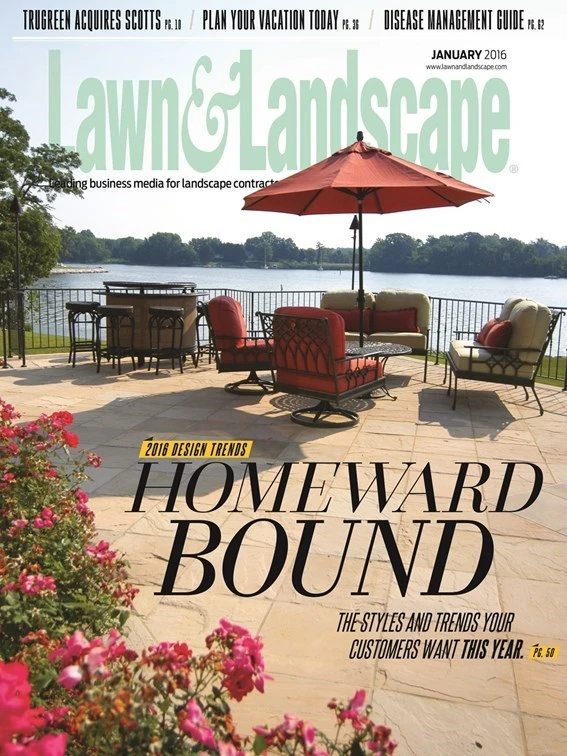_fmt.png)
Water has been a hot topic for a while, and that’s most likely not going to change in 2016.
As you start getting calls for irrigation installations and maintenance this year, consider adding smart controllers to your offerings.
Crawford Landscaping Group in Naples, Florida, started offering smart controllers six or seven years ago. Currently, the company retrofits controllers for customers trying to save money on their water bills.
Smart controllers receive data from local weather stations or the weather service and use that information to compute the evapotranspiration (ET) and adjust the irrigation of the landscape accordingly.
“It basically allows the controller to determine how much water is needed for the landscaping based on how much info you provide,” Mahan says. “Some controllers, you enter type of plants, type of soil, sun exposure. All of those elements are very important. Not every zone is going to be the same or need the same treatment.”
“It’s the responsible thing to do,” says J.C. Wheaton, manager of Centerville Irrigation in Ohio. The company started using smart controllers six or seven years ago and currently sells them on new installations and retrofits them when a controller stops working in the field.
The company installs a combination of a controller and a smart sensor, which can sense the local weather conditions. The system can be programmed so that the sensor alerts the controller to the current conditions without needing a person to do anything.
Mahan says this is important because the monitor at the shop alerts you if something’s wrong far before you’d notice when making a monthly check with a regular system.

Customer service.
It’s not just contractors who like using smart controllers. Customers like it, too.
“Consumers like it because it saves them from either having to go to the box themselves or calling us for a return trip,” Wheaton says.
He says they also like it because it’s a “one stop” service.
“You install it. You allow it to learn, and they really like the fact that it will automatically adjust to the temperature,” he says. “They don’t have to go out three times or four times a season to adjust everything.”
Wheaton says that’s the best selling point he uses when visiting new customers. “You’re saving them the hassle with keeping the property the way they want.”
Mahan says the most important part of the system is making sure it’s set up correctly.
“You really want to do a thorough evaluation of the system,” he says. “The first 60 days you really want to monitor it, fine tune it, to make sure it’s not over or under watering. It does take a lot of upfront work to get it set up, but once it’s set up you can pretty much leave it alone and let it do its thing.” Customers may be wary about the system because it costs more than a traditional controller, but Wheaton and Mahan say the savings in the long run make it a much better deal. “It saves the client money,” Mahan says. “It saves so much money in fact, that they typically pay for themselves within the first year.”
While Wheaton has seen other companies in his area offering smart controllers on residential jobs, he says he’s not seeing them overly stocked on commercial projects yet.
“I’d like to see more specced out on commercial projects,” he says, adding that architects and designers should be using more current products in their designs for maximized efficiency.
“You see them all the time running in the rain, no matter what town you’re in,” Wheaton says. “Running too long, running in the gutter, running in the rain because they were not put in correctly with the right components.”
Drawbacks.
Putting in smart controllers will cost the company more, still less than $100, Wheaton says, but the customer will see both energy and water savings.
“You’re going to lose control of how much time the zones are running and when,” Mahan says.
“You’re basically turning that over to the clock to make those decisions, which isn’t always a bad thing. But sometimes the homeowner or resident wants to know their irrigation schedule and you can’t necessarily tell them that.”
Another downside is that your company will see fewer service calls, but Wheaton says the type of contractor who is upset by that isn’t the type that he thinks will benefit from using a smart sensor.
“A lot of contractors don’t get additional service calls in the middle of the season,” he says. “But it’s about the efficiency of getting the best product to your customer. Those callbacks can be used other ways, such as zoning and monthly business checks.”
Mahan says installing smart controllers also opens up another level of service contractors can provide your clients.
“They can become a water manager and charge for that service,” he says. “It’s more than just fixing a broken sprinkler head.”
L&L
Explore the January 2016 Issue
Check out more from this issue and find your next story to read.
Latest from Lawn & Landscape
- Project EverGreen helps revitalize Milan Park in Detroit
- Trex Company wins Product of the Year, Judges’ Choice Winner at Environment+Energy Leader Awards
- General Equipment & Supplies in Fargo adds Takeuchi equipment
- Mariani Premier Group acquires Hazeltine Nurseries
- EnP Investments adds Mark McCarel as Northeast territory sales manager
- Our April issue is now live
- Ready or not
- Tribute to an industry guru






